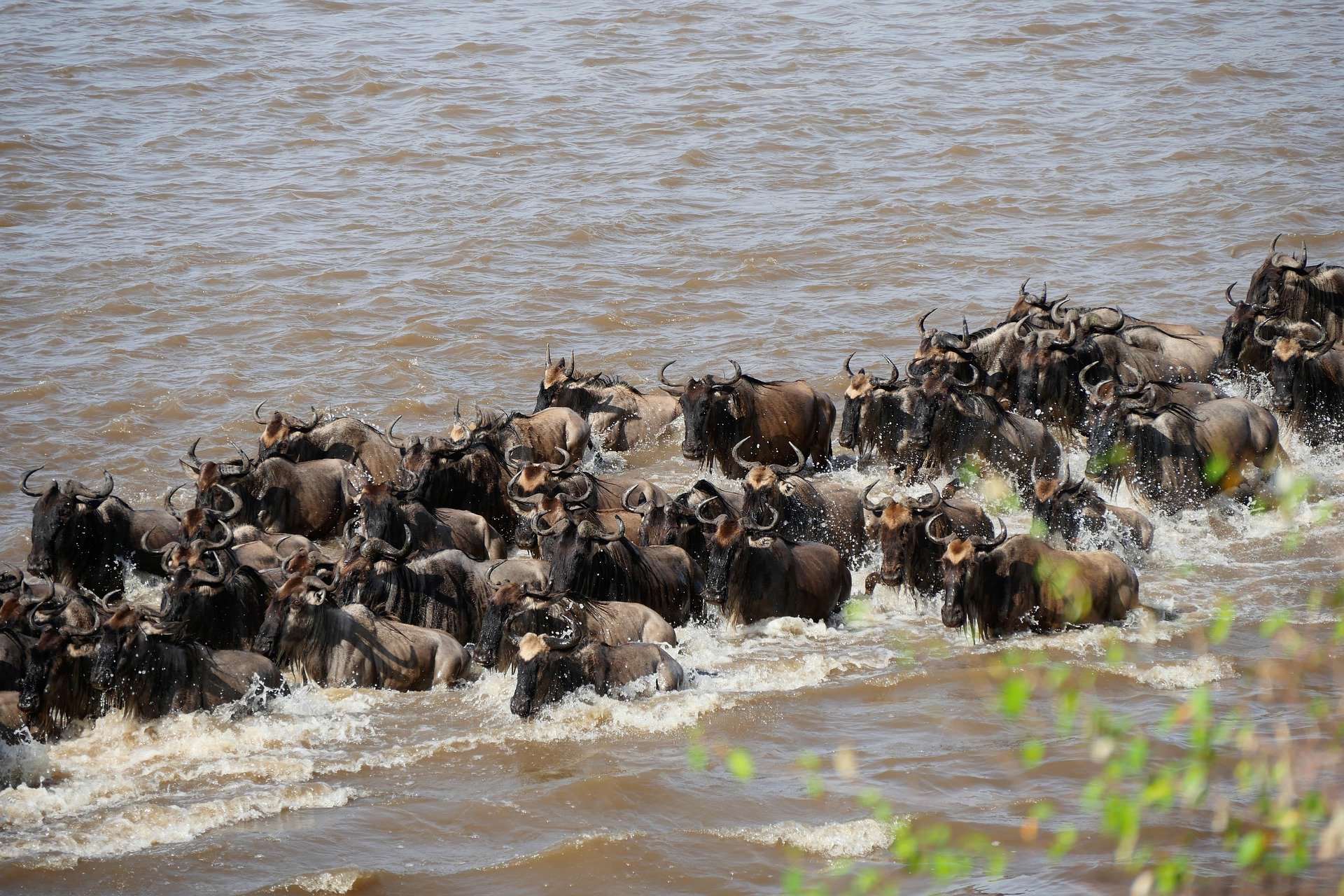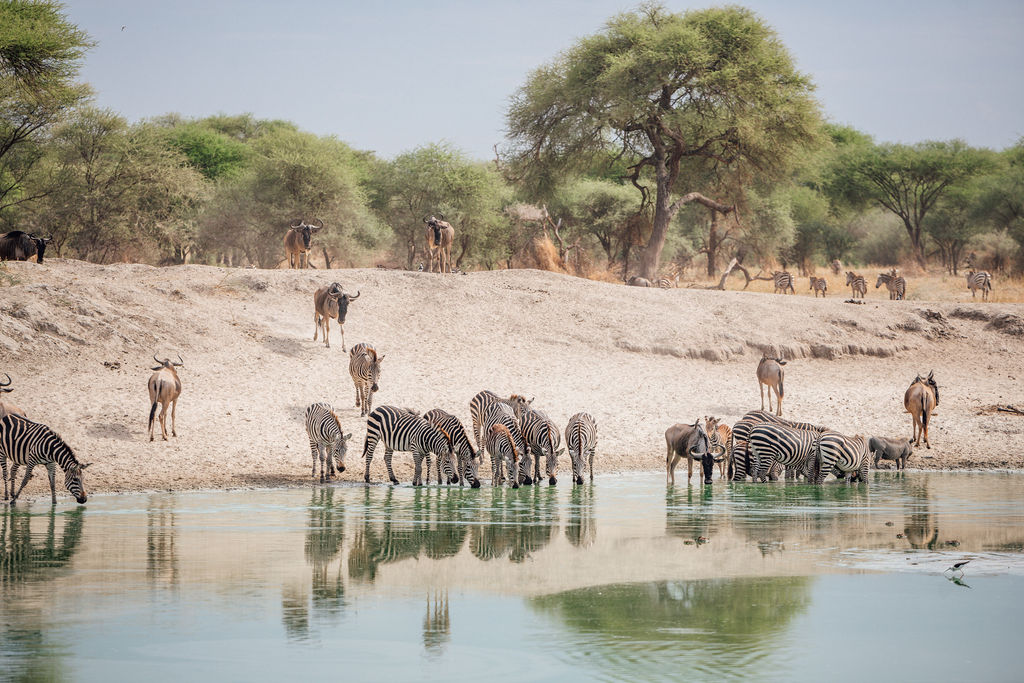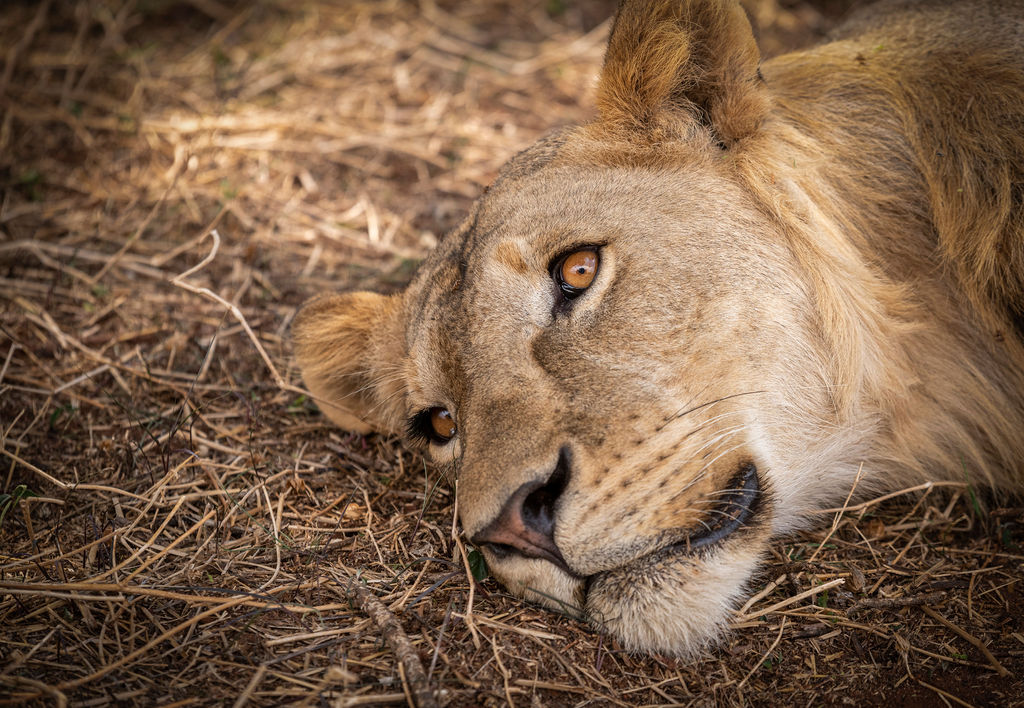SERENGETI NATIONAL PARK
- Best Time: June to October
- High Season: July to September
Serengeti National Park is a true African gem, a place where the wild heart of nature beats freely across endless golden plains. Located in northern Tanzania, this iconic park spans over 14,750 square kilometers and is part of the larger Serengeti ecosystem, which stretches into Kenya’s Maasai Mara. It’s a UNESCO World Heritage Site and one of the most celebrated wildlife sanctuaries on the planet.
The Serengeti is synonymous with the Great Migration, one of the most awe-inspiring natural events on Earth. Imagine millions of wildebeest, zebras, and gazelles thundering across the savannah, pursued by predators like lions, cheetahs, and crocodiles. This dramatic cycle of life and survival unfolds year-round, offering visitors a front-row seat to nature’s raw beauty.
But the Serengeti is more than just the Great Migration. It’s a haven for the Big Five—lion, leopard, elephant, buffalo, and rhino—as well as countless other species, from graceful giraffes to playful hyenas. The park’s diverse landscapes, from open grasslands to riverine forests and rocky outcrops, create a stunning backdrop for unforgettable adventures.
Whether you’re a wildlife enthusiast, a photography lover, or simply someone seeking a deeper connection with nature, the Serengeti promises an experience like no other. Picture yourself on a game drive at sunrise, the golden light illuminating the savannah, or floating above the plains in a hot air balloon, the world stretching out endlessly below you.
So, what are you waiting for? The Serengeti is calling, and its wonders are waiting to be discovered. Pack your sense of adventure, grab your camera, and get ready to create memories that will last a lifetime. Your African safari dream starts here—don’t let it pass you by!
The Serengeti experiences a moderate climate, with temperatures ranging from 15°C to 25°C (59°F to 77°F) throughout the year. The park has two distinct seasons: the dry season (June to October) and the wet season (November to May). The dry season is characterized by sunny days and cooler nights, making it ideal for wildlife viewing. The wet season brings lush greenery and occasional rain showers, which are perfect for birdwatching and seeing newborn animals.
Things to Do
- Wildlife Safaris: Embark on game drives to spot the Big Five (lion, leopard, elephant, buffalo, and rhino) and other incredible species like cheetahs, giraffes, and hyenas.
- Witness the Great Migration: Experience one of nature’s greatest spectacles as millions of animals move across the plains (typically between July and October).
- Hot Air Balloon Rides: Soar above the Serengeti at sunrise for a bird’s-eye view of the landscape and wildlife.
- Birdwatching: With over 500 bird species, the park is a paradise for bird enthusiasts.
- Cultural Visits: Engage with the Maasai people and learn about their traditions and way of life.
The best time to visit Serengeti National Park is typically during the dry season, from late June to October. However, the park is a year-round destination, and the ideal time for your visit depends on your interests. Here’s a month-by-month guide to help you plan your trip:
January to February
This marks the start of Tanzania’s green season, making it a great time for birdwatching.
The Great Wildebeest Migration is concentrated in the Ndutu area, and it’s calving season, offering a chance to witness thousands of newborn wildebeest.
March
The weather is unpredictable, with a mix of dry and rainy days.
The wildebeest calving season comes to an end, but wildlife viewing remains excellent.
April to May
This is the peak of the rainy season, making movement around the park challenging.
The migration is usually in the south or central Serengeti.
Fewer travelers visit during this time, offering a more secluded experience.
June to August
The dry season begins, making it the peak time for safaris.
In June, the Great Migration crosses the Grumeti River in western Serengeti.
By August, the herds move north toward the Mara River, preparing for dramatic crossings into Kenya’s Maasai Mara.
September to October
The dry season continues, with fewer travelers compared to earlier months.
The migration is typically in Kenya’s Maasai Mara during this period.
November to December
Short rains begin, but the park remains accessible.
Traveler numbers are low, except for a small peak around late December and early January.
The migration starts returning to the southern Serengeti and northern Ngorongoro, making it an exciting time to visit.
No matter when you choose to visit, the Serengeti offers incredible wildlife experiences and unforgettable moments throughout the year!
Getting to Serengeti National Park
Serengeti National Park is located in northern Tanzania, stretching into southwestern Kenya. Reaching this iconic destination is convenient, with options to travel by road or air. Your journey typically begins with an international flight to one of Tanzania’s major airports: Julius Nyerere International Airport (Dar es Salaam), Zanzibar Airport, or Kilimanjaro International Airport (near Arusha). From there, you can either take a domestic flight directly to the Serengeti or travel to nearby towns like Arusha or Mwanza and continue by road.
Getting to Serengeti National Park by Road
The most popular way to reach the Serengeti by road is by booking a drive-in safari. These safaris usually start from Arusha, a bustling town known as the gateway to Tanzania’s northern safari circuit. The drive from Arusha to the Serengeti takes approximately 7 hours (318 km) and is often part of a multi-day safari itinerary. Along the way, you’ll have the chance to stop at other wildlife-rich areas, such as the Ngorongoro Conservation Area, and enjoy overnight stays to break up the journey.
Serengeti Access Gates
The park has several entry and exit points, each serving different routes and regions:
Naabi Hill Gate: The main and busiest gate for visitors coming from Arusha, located 45 km from Seronera, the park’s central hub.
Ndabaka Gate: The primary gate for accessing the Western Corridor, about 1.5 hours from Mwanza and 145 km from Seronera.
Klein’s Gate: Situated in the far northeast, this gate is ideal for travelers combining visits to the Serengeti, Ngorongoro Crater, and Lake Natron.
Ikoma Gate: Located between Tabora B and Ndabaka gates, it’s a convenient entry point for certain routes.
Tabora B Gate: Mostly used by visitors driving from northern Tanzania (like Mwanza) who wish to explore the northern Serengeti.
Bologonja Gate: Currently not in use.
Serengeti Fly-In Safaris (Airstrips)
For those seeking a faster and more convenient option, flying into the Serengeti is an excellent choice. Several airstrips serve the park, and you can book either private charter flights or scheduled flights. Scheduled flights operate year-round from Arusha, Zanzibar, and Dar es Salaam, making it easy to connect to the Serengeti. Private charters are also available and can be arranged to suit your itinerary. This option is perfect for travelers with limited time or those looking for a more exclusive experience.
Whether you choose to drive through the scenic landscapes or fly in for a quicker journey, reaching the Serengeti National Park is an adventure in itself. Once there, you’ll be greeted by the park’s unparalleled beauty and wildlife, ready to create memories that will last a lifetime.
Where to Visit & Stay
- Seronera Valley: The heart of the Serengeti, known for its abundant wildlife and central location.
- Grumeti River: A prime spot for witnessing river crossings during the Great Migration.
- Lobo Valley: Offers stunning landscapes and fewer crowds, ideal for a peaceful safari experience.
For accommodations, the Serengeti offers a range of options, from luxury lodges to budget-friendly campsites. Some popular choices include:
- Four Seasons Safari Lodge: A luxurious retreat with stunning views of the savannah.
- Serengeti Serena Safari Lodge: Blends seamlessly with the environment and offers excellent service.
- Public Campsites: Perfect for budget travelers who want to immerse themselves in nature.
Suggested Serengeti Np Tours

Private Tour
Mid-Range
Lodge & Tented
5/5 (10 Reviews)
- 8 Days
You Visit: Arusha (Start), Tarangire, Serengeti National Park, Ngorongoro (End)

Private Tour
Mid-range
Lodge & Tented
5/5 (07 Reviews)
- 3 Days
You Visit: Zanzibar (Start), Mikumi National Park, Zanzibar (End)

Private Tour
Mid-Range
Lodge & Tented
5/5 (12 Reviews)
- 4 Days
You Visit: Zanzibar (Start), Mikumi National Park, Zanzibar (End)


